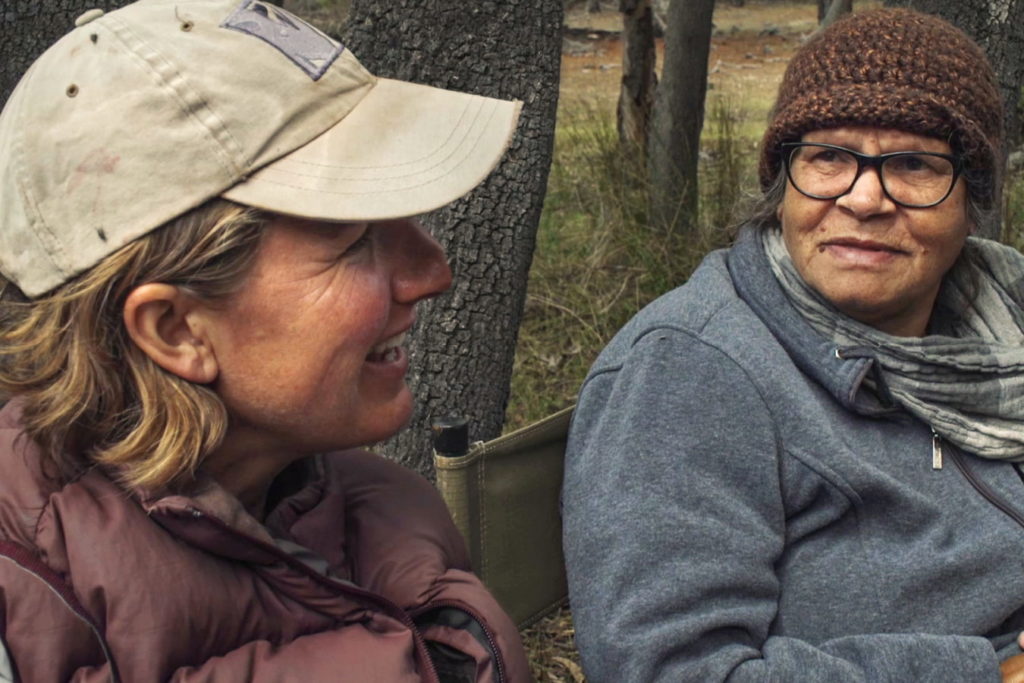Lynette Knapp and Alison Lullfitz walking together on Country
Aunty Lynette Knapp and Dr Alison Lullfitz are colleagues and friends who collaborate on Walking Together, a four year UWA Albany research project. Lynette and Alison are walking and talking together on the bush property where Alison lives beside the Marra (Pallinup River), at Boxwood Hill. Connection to Country is a strong thread in their friendship.
Lynette begins by describing how the plant Talyeraark, which occurs on an ancient marine plain formed thirty million years ago, is a marker of her Merningar Country.
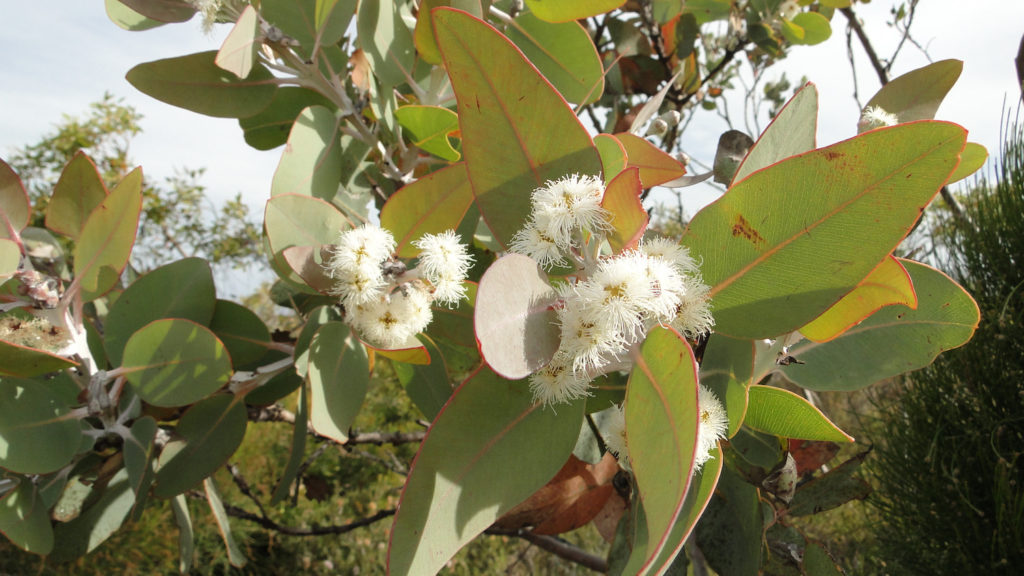
Lynette Knapp: Traditionally, we know our Country by the plants that grow there. Merningar or Menang Country is the heart and soul of my existence. It is from the Southern Ocean to the end of the Talyeraark (Eucalyptus pleurocarpa, blue mallee) in the north, and from Denmark to Israelite Bay.
Talyeraark tells me where I belong. If I took my father anywhere out of Country and we were travelling home at night, the minute the headlights hit those leaves they just lit up like silver, and he’d say, “Oh my girl, I’m home.”. That’s what Talyeraark means to me – it’s home.
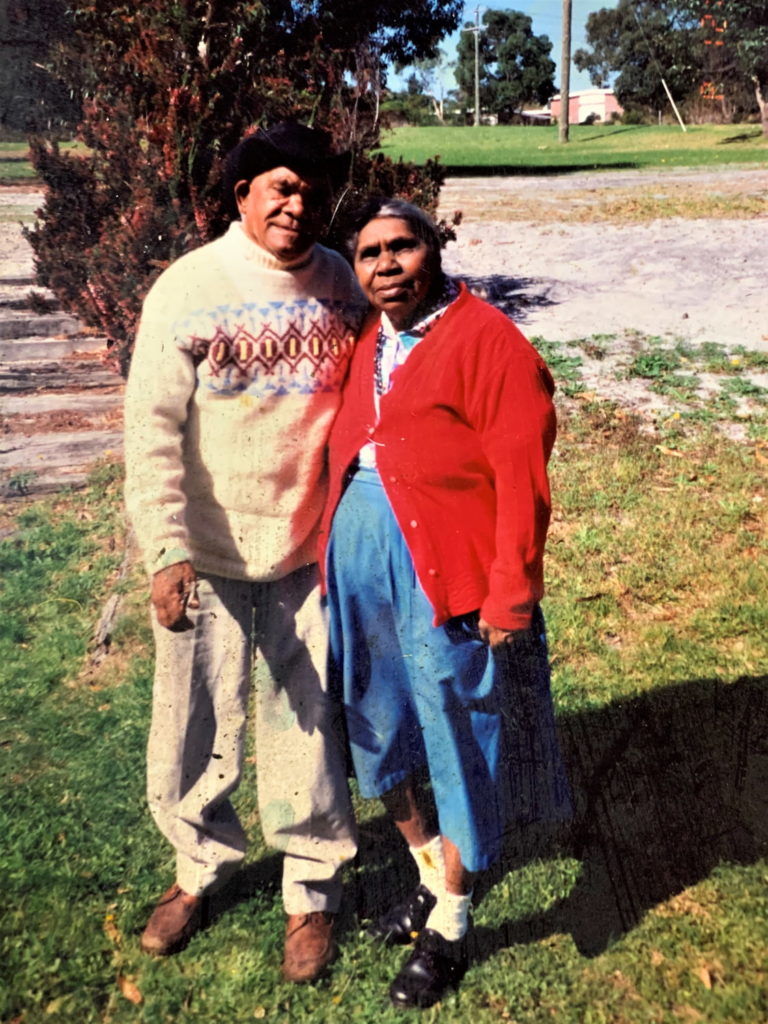
Alison Lullfitz: I feel pretty grateful to have grown up in this landscape.
The farm where my family lived was next to the Fitzgerald River National Park. We were in really diverse kwongan heath and there were also some beautiful creeks with big Mo trees, as I know them now; back then we called them Yates.
My dad left large areas of bush at the back of our farm uncleared so my brothers and I used to spend a lot of time out there trapping rabbits, looking for orchids and on the creekline granites. I can’t remember specifically learning that we lived in this richly biodiverse place, and we wouldn’t have used that language, but we just grew up knowing it was special, even though we’d never really been anywhere else.

Lynette: Totems are a big part of Noongar connection to Country. We’re totemic people. Every Noongar family has a plant and an animal totem, so that makes us part of this ecological system. We’re an integral cog in the wheel of the Australian bush. This is us. We belong here.
Borongur is our word for totem. We believe that when we die, our spirits go back into our totems to replenish and keep them going. When totems die, they become totemic spirits ‒ their spirits go back into the rocks out at Borongurup, or Porongurup, as it is now. It’s an absolute shrine. Rocks hold all our secrets.
We have to look after our borongur and if we fail to there are consequences, not so much in punishment, but it’s taken away because you’re not looking after it properly.
Djiuk is my totem plant. It’s also called emu bush (Exocarpos sparteus). The ends, when they come out, are like tiny babies’ dummies and they go pink ‒ they’re lovely and sweet.
My animal totem is the yeerdi yeerdi bird (Western Gerygone). If we’re camped somewhere and we hear her, we know someone’s coming. I can’t describe her to you because I haven’t seen her. I’ve only heard her. She tells us everything.
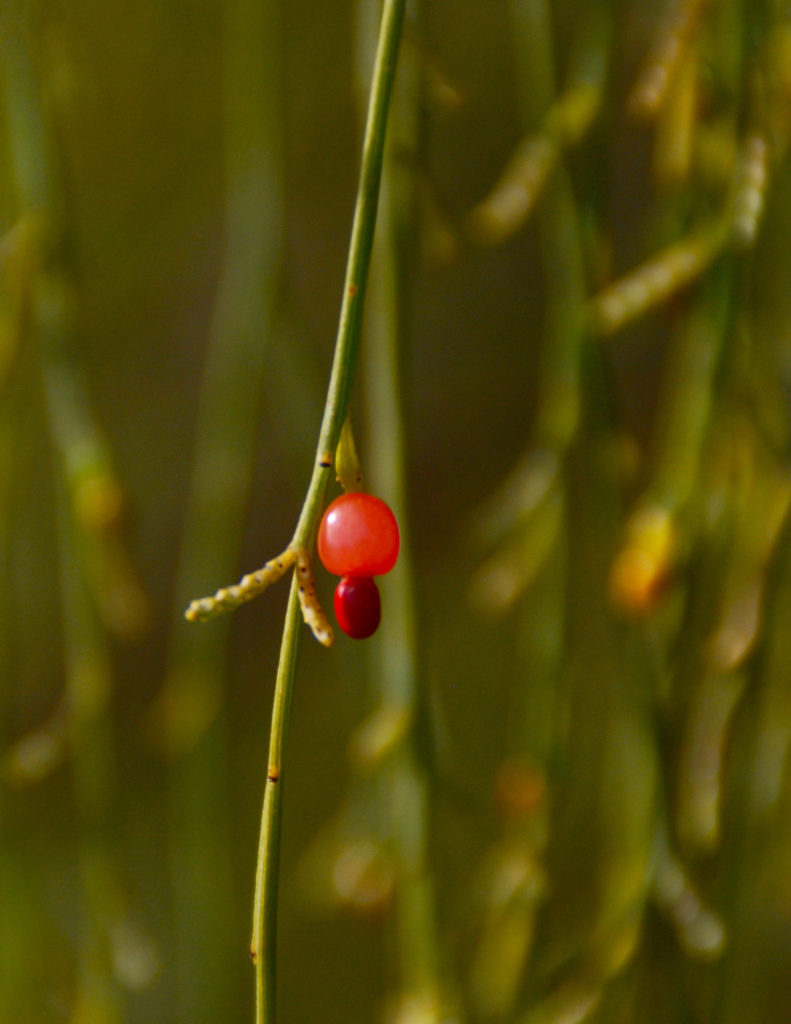
Alison: Is the reason that you haven’t seen it because you aren’t allowed to?
Lynette: That’s right! No, you can’t look at it.
To Noongar people, Country, including the underground world, is inspirited, and being connected to Country is imperative.
Lynette: When we’re going through Country past all the swamps, we know they’re all connected underground. We’ve got a world down there as well as up here.
Swamps are breath holes of great creation serpents travelling underground. They come up for air, then go underground to the next one. My family looks at those swamps as where the serpent took a deep breath.
It hurts me to see all those swamps and waterways being cleared because it compresses the ground and the world underneath stops. Everything disappears.
As kids, we were taught not to go near waterholes because of the great serpents that lived in them. I remember at Bremer Bay, us kids wagging school and sneaking to waterholes around the town. There’s none there now because they’ve been filled in. We went to one with this great big black and white serpent. I remember it just rolling over into the water and disappearing. And that was the last time I went and disturbed anything. We got in a lot of trouble for doing that.
I was sick as a child so didn’t go to the mission, but my brothers and sisters were taken away. You can see that link to culture that’s been damaged, like a swamp that’s been filled in. The waterway has been broken, compressed, and that’s what’s happened to my brothers and sisters.
My cousin Carol and I represented our family on the Southwest Aboriginal Land and Sea Council Working Group. Initially, I wasn’t sure about it. After the first meeting, I went home to Dad and asked, “What is your connection to Country?”. He had a good old think and said, “Well, my girl, when my mummy found me”, in other words, when he was born ‒ it was a no-no to talk about birth kind of stuff, “all the yorgas (women) had a yardie (ceremonial dance) and everything to do with Mum finding me was buried in the ground. That’s my DNA connection to this Boodja, my Country. It’s your connection to this Country, and your kids’, their kids’ and their kids’.” He said, “No-one can get that DNA out. They can bulldoze the place down and put it over there in a big heap, but it will be still in the soil. They can’t get rid of it. So that’s our connection to this Country.”
I was satisfied then because it helped me understand his need to be connected to Country. For an old man to tell me things like that, I knew it was very important.
Country brims with important features.
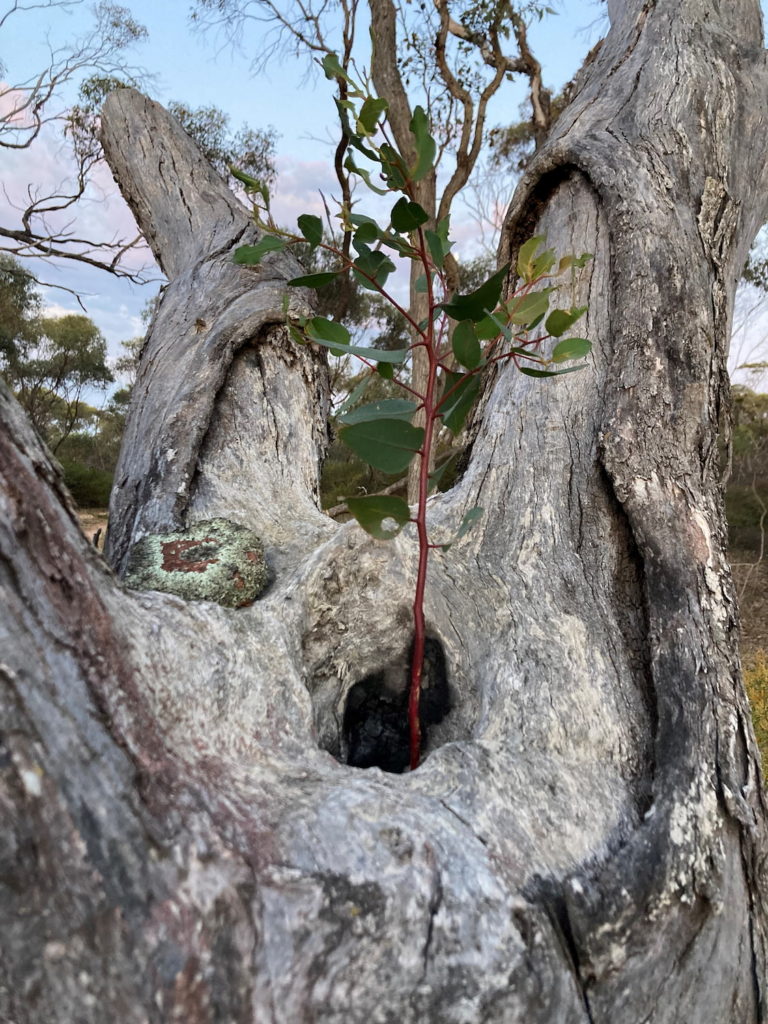
Lynette: We’re lucky in a way that you, Ali, and Rob own this property on the Marra because here there is what we call gnaama boorna ‒ a water tree. Gnaama boorna – tree is boorna, gnaama is water.
See how the bark on the branches is used to catch the water as it comes down from the tree and it just redirects it down here to fill that up. Like a funnel. This is one of the methods of farming water. This is a very special, ceremonial tree with medicinal water. It is part of a dreaming path we call wiiern yeiirt.
Moodjar ‒ the WA Christmas Tree ‒ is a soul tree.
Lynette: I’ve never known any Noongars to camp under Moodjar (Nuytsia floribunda), WA Christmas Tree). We were taught to leave it alone and let it grow ‒ it’s our soul tree. For Aboriginal people, souls are a big thing and Moodjar is the pathway to Kooranup, the place between the sky and the sea. It’s our heaven. Koora means long time ago, or long way to go. These trees are where souls begin those travels and we don’t want them following us instead, so we steer clear of camping under them. They’re sacred.

Alison: So it’s the link between us real living people and Kooranup?
Lynette: Yes, our souls sit in those branches and wait for others to join them, and then they take their journey to Kooranup.
When their flowers come out around Christmas time, we believe they’re our ancestor’s souls coming back to look over their Country. So we don’t pick the flowers. That would kill our souls.
Respecting Country is part of Noongar culture.
Lynette: We call mountains and hills kaart. It is the same word for your head. So hills, or kaart, are like the human heads of Country ‒ they’ve got eyes and ears. They’re watching our every move, so we have to show those kaart special consideration. We have to respect them. If we don’t respect them, it’ll come back to haunt us.
We belong to the bush because our totems are an integral part of it. That’s how we live and what we believe. It hurts to see things knocked down. It’s like losing a limb ‒ it’s a part of you, and it hurts.
You know, no one comes to blackfellas to ask, “Can we build a house here or put a building there, and why does it matter if we do?”. Of course it matters because when you knock down the bush, it’s removing our culture.
And I suppose that’s why it was so easy to take Country off us because there was no ownership of Boodja. We are part of it, but we don’t own it, it owns us. When people came along putting up fences and knocking all our bush down, it stopped everything for us.
As a child, I used to watch those great tractors with big chains just destroying mallee Country. It was heartbreaking because when they cleared the mallee, the great chains would go through, and then it’d be all flat. And all of a sudden one little tree would pop its head up like, “Help me!” You know, it was so distressing.
Ali, this is the only property I’ve been on without a fence. Fences were a great big part in chucking us out of our Country. Our family knows that we can come here any time of the day, doesn’t matter when and we’re welcome. Yeah. It’s different, you’re treating the Country with respect and that’s the way I think it all should be.
Alison: I think since getting to know you and other Elders I feel a much greater sense of responsibility. Your Old People looked after this for tens of thousands of years and now we’ve got that privilege because they looked after it so well. It feels like a responsibility we have to them.
Lynette: When we first got together, we came and burnt some patches here, and it was wonderful seeing my boy and your girls going through looking for bardi grubs as we burned. They were having a good old feed and learning. It was awesome.
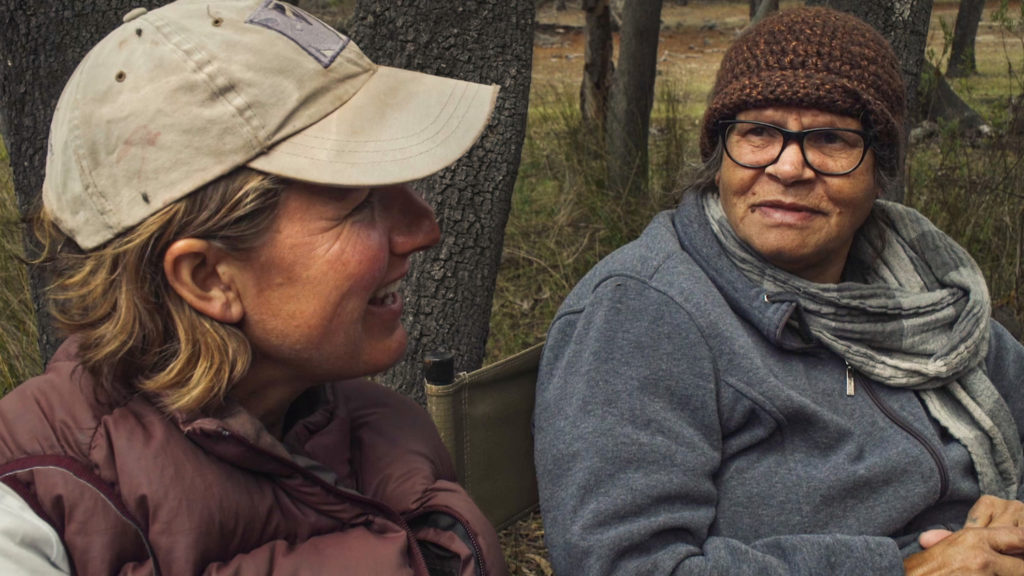
Alison: I loved that day. You were showing the kids how to cook the bardies on the fire and it just felt like that’s how it should be.
Lynette: Well, there’s been no difference between us here, has there?
Alison: Well, I’ve learned a lot from you.
Lynette: And same here. I’ve learned from you.
Alison: I’ve learned that it’s a human landscape. I used to think how important wilderness was, you know, these untouched places, and now I think so differently. Now I think the worst thing that could ever happen to this place is for it to have no one to look after and love it. That’s been this flip in my mind, and it’s been since…
Lynette: We’ve corrupted you.
Alison: Ha, in a good way.
For this story, thanks to Lynette Knapp, Alison Lullfitz, the photographers and Gondwana Link. Thanks also to Frank Rijavec and Noelene Harrison.

